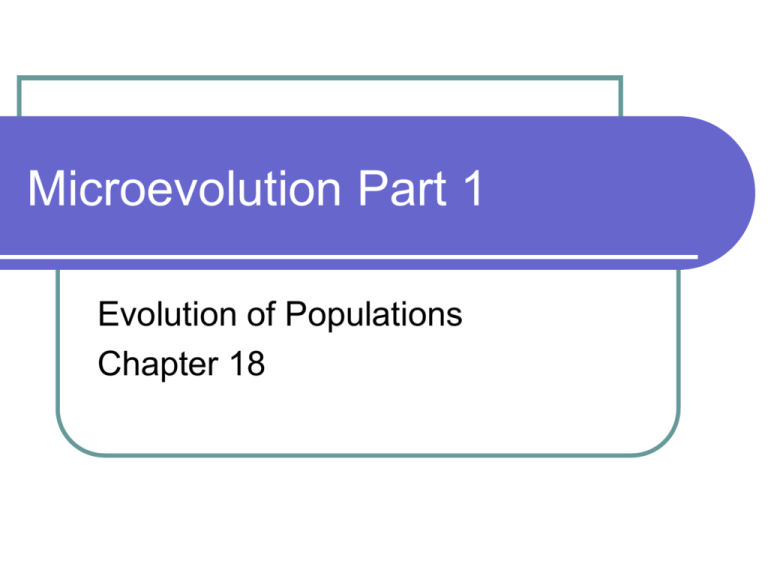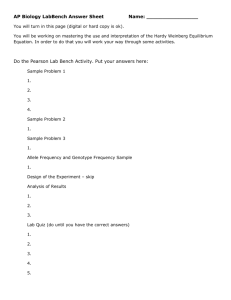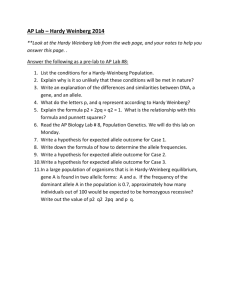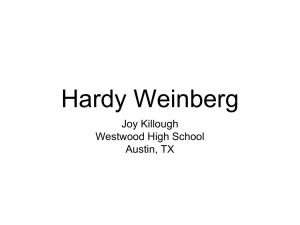File - AP Biology with Ms. Costigan
advertisement

Microevolution Part 1 Evolution of Populations Chapter 18 Some Vocabulary Microevolution – Evolutionary change below the species level Example: change in a population’s allele frequencies over generations Macroevolution – Evolutionary change above the species level including origin of a new group of organisms or a shift in the broad pattern of evolutionary change over a long period of time Examples: appearance of new organism features, mass extinction and recovery of diversity Populations Evolve Natural selection acts on individuals differential survival differential reproductive success “survival of the fittest” who bears more offspring Populations evolve genetic makeup of population changes over time favorable traits (greater fitness) become more common In Summary: Individuals DON’T Evolve Individuals survive or don’t Individuals reproduce or don’t Individuals are SELECTED Populations EVOLVE! Fitness Survival & Reproductive Success individuals with one phenotype leave more surviving offspring Body size & egg laying in water striders Variation & Natural Selection Variation is the raw material for natural selection there have to be differences within population some individuals must be more fit than others Nonconstancy of Species Nonconstancy refers to variation within a species This is part of Darwin’s theory There is variation within a species Example: dog and cat breeds All are capable of interbreeding but they look different. Where Does Variation Come From? Mutation random changes to DNA Wet year Beak depth Dry year Dry year errors in mitosis & meiosis environmental damage 1977 Dry year 1980 1982 1984 Sexual Reproduction mixing of alleles recombination of alleles new arrangements in every offspring new combinations = new phenotypes spreads variation offspring inherit traits from parent Beak depth of offspring (mm) 11 10 9 8 Medium ground finch 8 9 10 11 Mean beak depth of parents (mm) 5 Agents of Evolutionary Change Mutation Genetic Drift Gene Flow Non-random mating Selection Mutation Change from one allele to another Mutation changes the DNA sequence It may alter the resulting amino acid sequence which could effect the corresponding protein/enzyme Alters proportion of alleles in population Generally low mutation rates in a population Ultimate source of genetic variation making evolution possible Despite what the word “mutation” sounds like, it is not necessarily a bad thing! Chromosomal Mutations Deletion Inversion Translocation Chromosome Mutations Nondisjunction DNA Mutations Point Mutations Substitution Addition Deletion DNA Mutations Additions & Deletions may lead to a reading Frame Shift Gene Flow Movement of individuals & alleles in & out of populations seed & pollen distribution by wind & insect migration of animals sub-populations may have different allele frequencies causes genetic mixing across regions reduce differences between populations Non-Random Mating Example - Sexual selection Genetic Drift Effect of chance events founder effect small group splinters off & starts a new colony bottleneck some factor (disaster) reduces population to small number & then population recovers & expands again Natural Selection Differential survival & reproduction due to changing environmental conditions climate change food source availability predators, parasites, diseases toxins combinations of alleles that provide “fitness” increase in the population adaptive evolutionary change Selection How Do Populations Change? The 5 agents of evolutionary change create opportunities for changes in allele frequency in a population Population Genetics is the study of the properties of genes within a population Using the Hardy Weinberg Rule a scientist can set up a reference equilibrium point to monitor genetic frequency changes in a population. Hardy Weinberg Equilibrium Under the following conditions no evolution should take place and allele frequencies should remain constant in a population: No Mutation (no modifications to the gene pool) No Natural Selection (no differences in survival or reproductive success) Extremely Large Population (no genetic drift) Random Mating (no one is more/less attractive) Isolated Population/No Gene Flow (no Immigration - entering or Emigration - exiting) Hardy Weinberg Equilibrium A mathematical equation exists to track genotype and allele frequencies in a population The Hardy Weinberg Equilibrium Equation looks like this: p2 + 2pq + q2 = 1 A a p2 + 2pq + q2 = 1 p2 = frequency of homozygous dominant genotype q2 = frequency of homozygous recessive genotype EX: 25% of population with “AA” genotype EX: 25% of population with “aa” genotype 2pq = frequency of heterozygous genotype EX: 50% of population with “Aa” genotype p+q=1 This is the second part of the Hardy Weinberg equation p = frequency of dominant allele EX: 50% have an “A” allele q = frequency of recessive allele EX: 50% have an “a” allele Hardy-Weinberg Practice Total # of students: # without Widow’s Peak: q2 = q= p= p2 = 2pq =









